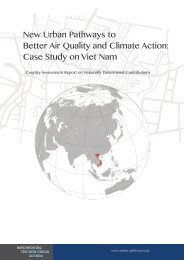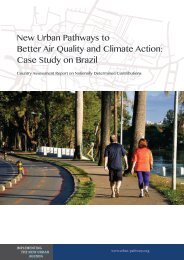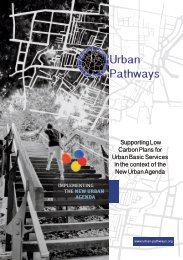Kenya
You also want an ePaper? Increase the reach of your titles
YUMPU automatically turns print PDFs into web optimized ePapers that Google loves.
<strong>Kenya</strong>´s National Strategy aims to curb<br />
greenhouse gases such as carbon dioxide<br />
(CO2), methane (CH4) and nitrous oxide<br />
(N2O) in sectors such as, energy, transportation,<br />
industrial processes, agriculture, forestry<br />
and other land use and waste sector.<br />
Their planning process will include a review<br />
of the National Climate Change Action Plan<br />
(NCCAP) and the National Adaptation Plan<br />
(NAP) through the National Climate Change<br />
Secretariat (NCCS) every five years.<br />
Through the regular review process, the National<br />
Strategy also streamlines the climate<br />
change mechanism in all relevant ministries<br />
and will oversee the <strong>Kenya</strong>n Climate Fund.<br />
2. National Policies and Plans<br />
supporting the NDC target<br />
<strong>Kenya</strong> is committed to achieving its NDC<br />
targets based on existing laws and national<br />
policies. In recent years, <strong>Kenya</strong> has developed<br />
a National Climate Change Response<br />
Strategy (NCCRS 2010), a National Climate<br />
Change Action Plan (NCCAP 2013), a National<br />
Adaption Plan (NAP) and a Climate<br />
Change Act (2016) to curb the increased<br />
emissions in the country.<br />
Important official documents, which help<br />
contributing to the 1.5 Degree target:<br />
1. Constitution of <strong>Kenya</strong> (2010)<br />
2. Vision 2030 of the National Climate<br />
Change Action Plan (2013-2017) has been<br />
developed as a blueprint for flagship programmes<br />
and projects relating climate<br />
change adaptation and mitigation, including:<br />
• the Integrated National Transport Policy<br />
(2010),<br />
• the National Policy for the Sustainable<br />
Development of Northern <strong>Kenya</strong> and other<br />
<strong>Kenya</strong> wants to balance<br />
the need for economic<br />
growth with<br />
environmental protection<br />
Arid Lands,<br />
• the National Disaster Management<br />
Plan (2012)<br />
• the Environmental Management and<br />
Coordination Act (1999)<br />
• Water Act (2002)<br />
• the Energy Policy and Act<br />
(2004,2006,2012)<br />
• the Agricultural Sector Development<br />
Strategy 2010-2020<br />
• the <strong>Kenya</strong> Forestry Master Plan 1995-<br />
2020<br />
• the Second National Environment Action<br />
Plan (2009-2013)<br />
• Threshold 21 (T-21)<strong>Kenya</strong>, a dynamic,<br />
quantitative and transparent planning tool<br />
for climate adaptation.<br />
2.1 National Urban Policies<br />
Increasing population and migration to urban<br />
areas, due to growing economic and social<br />
segregation, threatens <strong>Kenya</strong>´s environment<br />
and liveability standards in cities, while<br />
also limiting access to basic urban services<br />
(GIZ, 2013). <strong>Kenya</strong>´s National Urban Policies<br />
have the potential to improve access to basic<br />
urban services through proper planning<br />
and design, e.g. through public spaces and<br />
public infrastructure development. Hence,<br />
IMPLEMENTING<br />
THE NEW URBAN<br />
AGENDA<br />
www.urban-pathways.org








